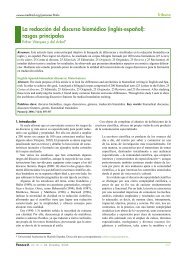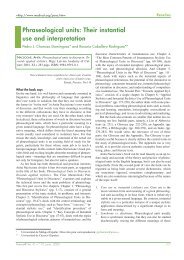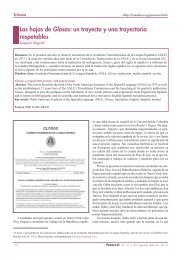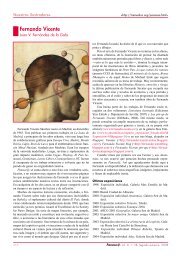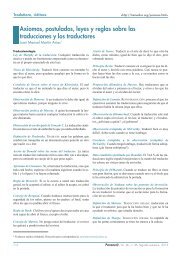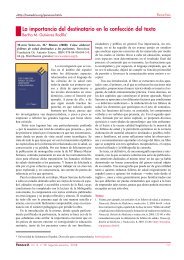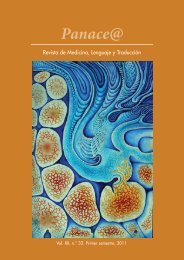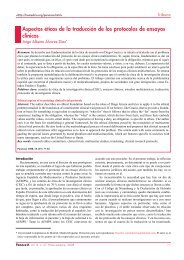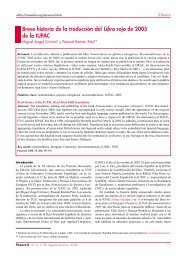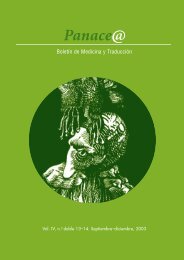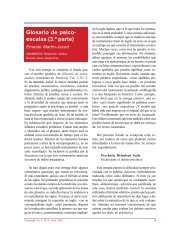Vol. 1, n.º 2. Diciembre del 2000
Vol. 1, n.º 2. Diciembre del 2000
Vol. 1, n.º 2. Diciembre del 2000
Create successful ePaper yourself
Turn your PDF publications into a flip-book with our unique Google optimized e-Paper software.
Otra corresponsal con formación botánica<br />
señaló que a menudo se atribuye a las stem cells<br />
embrionarias de los animales o humanos una totipotencia<br />
que no tienen y que, en cambio, las stem<br />
cells de los meristemas apicales e incluso otros<br />
tipos celulares de las plantas vasculares teóricamente<br />
sí podrían producir un organismo vegetal<br />
completo con las técnicas de cultivo celular<br />
in vitro más actuales, partiendo de protoplastos<br />
aislados. Muy a menudo los conceptos<br />
de totipotencia y pluripotencia se confunden.<br />
En conclusión, para traducir stem cells, en<br />
ausencia de contexto específico, se puede recurrir<br />
a las alternativas de traducción más generales<br />
citadas arriba (células precursoras, células<br />
troncales, etc.). Cuando se explicite el tejido de<br />
origen pueden utilizarse traducciones más específicas,<br />
como «hemocitoblastos» u «osteocitoblastos».<br />
Otra opción sería uniformar la nomenclatura<br />
traduciendo stem cells por «citoblastos»<br />
de manera general y anteponerles el afijo específico<br />
de tejido u órgano cuando cupiera: hemo–<br />
, neuro–, hepato–, etc. La traducción por «células<br />
madre» no refleja adecuadamente lo que son<br />
las stem cells, y el adjetivo «pluripotente» (y no<br />
«pluripotencial») puede utilizarse, pero con reservas,<br />
y en los casos en que las células precursoras<br />
o troncales realmente lo sean.<br />
Referencias<br />
1. Izquierdo Rojo M. Ingeniería genética y transferencia<br />
génica. Ediciones Pirámide; 1999.<br />
<strong>2.</strong> Johansson CB et al. Identification of a neural stem cell<br />
in the adult mammalian central nervous system. Cell<br />
1999;96:25-34.<br />
3. Watt FM, Hogan BLM. Out of Eden: stem cells and<br />
their niches. Science <strong>2000</strong>;287:1427-1430.<br />
4. Alberts B et al. Biología molecular de la célula, 3.ª ed.<br />
1996.<br />
5. Stem Cells: A Primer. Doctors Who’s Who, Inc., <strong>2000</strong><br />
(http://www.doctorswhoswho.com/medical_library/<br />
procedures_treatments/transplantation/<br />
stem_cells_a_primer.htm).<br />
6. Thomson JA et al. Embryonic stem cell lines derived<br />
from human blastocysts. Science 1998;282:1145-147.<br />
7. Vogel G. Capturing the promise of youth. Science<br />
1999;286:2238-2239.<br />
8. Peters T. The stem cell debate: ethical questions. Center<br />
for Theology and the Natural Sciences (http://<br />
www.ctns.org/Information/information.html)<br />
9. Whetton A, Graham GJ. Homing and mobilization in<br />
the stem cell niche. Trends Cell Biol 1999;9:233-238<br />
10. Lowell S. Stem cells show their potential. Trends Cell<br />
Biol <strong>2000</strong>;10:210-211.<br />
11. Van der Kooy D, Weiss S. Why stem cells. Science<br />
<strong>2000</strong>;287:1439-1441.<br />
1<strong>2.</strong> Gage FH. Discussion point: stem cells of the central<br />
nervous system. Curr Opin Neurobiol 1998;8:671-676.<br />
13. Lenhard M, Laux T. Shoot meristem formation and<br />
maintenance. Curr Opin Plant Biol 1999;2:44-50.<br />
14. Schnittger A, Schellmann S, Hülskamp M. Plant cellsyoung<br />
at heart? Curr Opin Plant Biol 1999;2:508-51<strong>2.</strong><br />
15. Real Academia de Ciencias Exactas, Físicas y Naturales.<br />
Vocabulario científico y técnico. Madrid: Espasa-<br />
Calpe; 1990.<br />
16. Schuldiner M. Effects of eight growth factors on the<br />
differentiation of cells derived from human embryonic<br />
stem cells. Proc Natl Acad Sci USA <strong>2000</strong>;97:11307-<br />
11312<br />
17. Heath CA. Cells for tissue engineering. TIBTECH,<br />
<strong>2000</strong>;18:17-19.<br />
18. Insulin-producing cells grown from stem cells. Reuters<br />
Health, Nueva York, 28/2/<strong>2000</strong>, comentario <strong>del</strong> artículo<br />
de Sachs DH, Bonner-Weir S. New islets from<br />
old. Nature Medicine <strong>2000</strong>;6:250-251.<br />
19. Johe KK, et al. Single factors direct the differentiation<br />
of stem cells from the fetal and adult central nervous<br />
system. Genes Dev 1995; 10:3129–3140.<br />
20. Bjornson CRR, et al. Turning brain into blood: a<br />
hematopoietic fate adopted by adult neural stem cells<br />
in vivo. Science 1999;283:534-537.<br />
21. Petersen BE, et al. Bone marrow as a potential source<br />
of hepatic oval cells. Science 1999;284:1168-1170.<br />
2<strong>2.</strong> Navarro FA. Traducción y lenguaje en medicina.<br />
Monografías Dr. Antonio Esteve. Barcelona: Fundación<br />
Dr. A. Esteve; 1997. pág. 29.<br />
23. Navarro FA. Diccionario crítico de dudas inglés-español<br />
de medicina. Madrid: McGraw-Hill-Interamericana;<br />
<strong>2000</strong>. pág. 48<strong>2.</strong><br />
24. Cambridge international English dictionary on-line<br />
http://dictionary.cambridge.org/.<br />
Panace@ <strong>Vol</strong>. 1, No. <strong>2.</strong> <strong>Diciembre</strong>, <strong>2000</strong>



